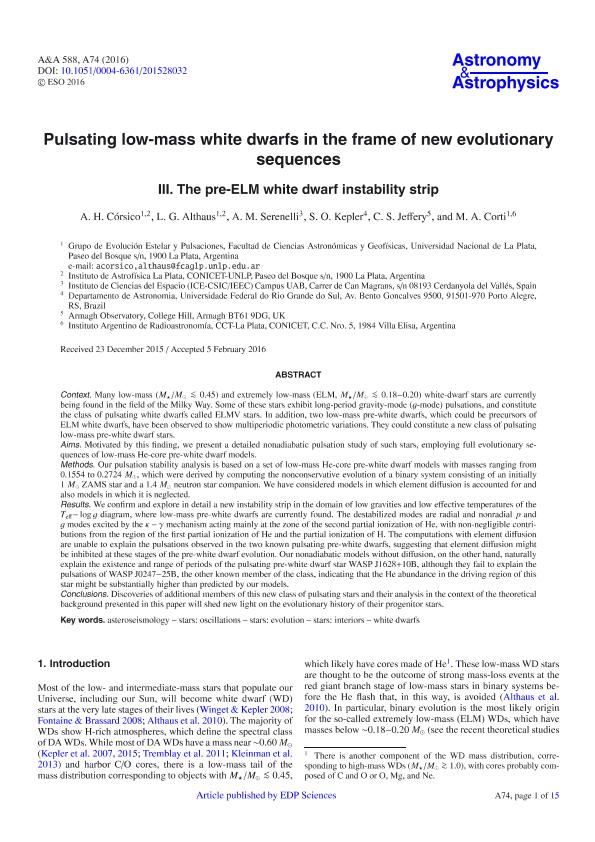Artículo
Pulsating low-mass white dwarfs in the frame of new evolutionary sequences: III. the pre-ELM white dwarf instability strip
Corsico, Alejandro Hugo ; Althaus, Leandro Gabriel
; Althaus, Leandro Gabriel ; Serenelli, A.M.; Kepler, S. O.; Jeffery, C.S.; Corti, Mariela Alejandra
; Serenelli, A.M.; Kepler, S. O.; Jeffery, C.S.; Corti, Mariela Alejandra
 ; Althaus, Leandro Gabriel
; Althaus, Leandro Gabriel ; Serenelli, A.M.; Kepler, S. O.; Jeffery, C.S.; Corti, Mariela Alejandra
; Serenelli, A.M.; Kepler, S. O.; Jeffery, C.S.; Corti, Mariela Alejandra
Fecha de publicación:
04/2016
Editorial:
EDP Sciences
Revista:
Astronomy and Astrophysics
ISSN:
0004-6361
Idioma:
Inglés
Tipo de recurso:
Artículo publicado
Clasificación temática:
Resumen
Context. Many low-mass (M∗/MȮ ≤ 0.45) and extremely low-mass (ELM, M∗/MȮ ≤ 0.18-0.20) white-dwarf stars are currently being found in the field of the Milky Way. Some of these stars exhibit long-period gravity-mode (g-mode) pulsations, and constitute the class of pulsating white dwarfs called ELMV stars. In addition, two low-mass pre-white dwarfs, which could be precursors of ELM white dwarfs, have been observed to show multiperiodic photometric variations. They could constitute a new class of pulsating low-mass pre-white dwarf stars. Aims. Motivated by this finding, we present a detailed nonadiabatic pulsation study of such stars, employing full evolutionary sequences of low-mass He-core pre-white dwarf models. Methods. Our pulsation stability analysis is based on a set of low-mass He-core pre-white dwarf models with masses ranging from 0.1554 to 0.2724 MȮ, which were derived by computing the nonconservative evolution of a binary system consisting of an initially 1 MȮ ZAMS star and a 1.4 MȮ neutron star companion. We have considered models in which element diffusion is accounted for and also models in which it is neglected. Results. We confirm and explore in detail a new instability strip in the domain of low gravities and low effective temperatures of the Teff - log g diagram, where low-mass pre-white dwarfs are currently found. The destabilized modes are radial and nonradial p and g modes excited by the κ - γ mechanism acting mainly at the zone of the second partial ionization of He, with non-negligible contributions from the region of the first partial ionization of He and the partial ionization of H. The computations with element diffusion are unable to explain the pulsations observed in the two known pulsating pre-white dwarfs, suggesting that element diffusion might be inhibited at these stages of the pre-white dwarf evolution. Our nonadiabatic models without diffusion, on the other hand, naturally explain the existence and range of periods of the pulsating pre-white dwarf star WASP J1628+10B, although they fail to explain the pulsations of WASP J0247-25B, the other known member of the class, indicating that the He abundance in the driving region of this star might be substantially higher than predicted by our models. Conclusions. Discoveries of additional members of this new class of pulsating stars and their analysis in the context of the theoretical background presented in this paper will shed new light on the evolutionary history of their progenitor stars.
Archivos asociados
Licencia
Identificadores
Colecciones
Articulos(IALP)
Articulos de INST.DE ASTROFISICA LA PLATA
Articulos de INST.DE ASTROFISICA LA PLATA
Articulos(IAR)
Articulos de INST.ARG.DE RADIOASTRONOMIA (I)
Articulos de INST.ARG.DE RADIOASTRONOMIA (I)
Citación
Corsico, Alejandro Hugo; Althaus, Leandro Gabriel; Serenelli, A.M.; Kepler, S. O.; Jeffery, C.S.; et al.; Pulsating low-mass white dwarfs in the frame of new evolutionary sequences: III. the pre-ELM white dwarf instability strip; EDP Sciences; Astronomy and Astrophysics; 588; A74; 4-2016; 1-15
Compartir
Altmétricas



